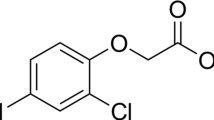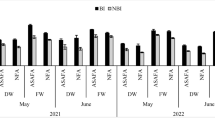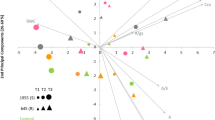Abstract
THE herbicide 2,4-D (2,4 dichlorophenoxyacetic acid) has been recorded to affect fungal-host relationship. Ibrahim1 demonstrated a reduction in the number of rust uredosori to one-fifth on treated oat plants compared with controls. Similarly, Crowdy and Wain2 recorded a suppression in bean chocolate-spot disease treated with 2,4,6 trichlorophenoxyacetic acid. On the other hand, wheat plants treated with 2,4-D were found to be weakened, stunted and predisposed to a heavier infection with Helminthosporium sativum 3. 2,4-D has been recorded to cause a depletion in the carbohydrate content of treated plants4,5; Weller and co-workers6 observed a depletion of non-reducing sugars.
This is a preview of subscription content, access via your institution
Access options
Subscribe to this journal
Receive 51 print issues and online access
$199.00 per year
only $3.90 per issue
Buy this article
- Purchase on SpringerLink
- Instant access to full article PDF
Prices may be subject to local taxes which are calculated during checkout
Similar content being viewed by others
References
Ibrahim, I. A., Phytopath., 41, 951 (1951).
Crowdy, S. H., and Wain, R. I., Ann. App. Biol., 38, 318 (1951).
Hsia, Y. T., and Christensen, J. J., Phytopath., 41, 1011 (1951).
Mitchell, J. V., and Brown, J. W., Bot. Gaz., 107, 120 (1945).
Wort, D. J., Amer. J. Bot., 36, 673 (1949).
Weller, L. E., and co-workers, Plant Physiol., 50, 289 (1950).
Gawadi, A. E., Ph.D. thesis, Cambridge (1935).
Menon, K. P. V., Ann. Bot., 48, 187 (1934).
Author information
Authors and Affiliations
Rights and permissions
About this article
Cite this article
MOSTAFA, M., GAYED, S. Effect of Herbicide 2,4-D on Bean Chocolate-Spot Disease. Nature 178, 502 (1956). https://doi.org/10.1038/178502a0
Issue date:
DOI: https://doi.org/10.1038/178502a0
This article is cited by
-
Foliar spray of gibberellic acid and its influence on the rhizosphere and rhizoplane mycoflora
Plant and Soil (1971)
-
Auxins
The Botanical Review (1959)



